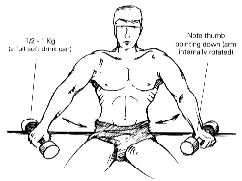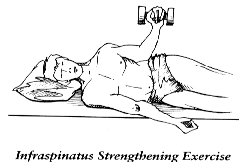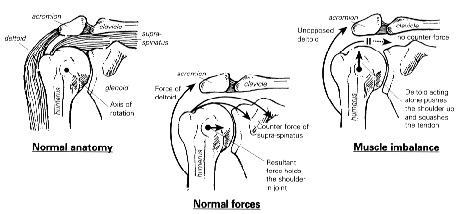Alternatively the space itself can be narrowed, usually where the acromion itself is large and prominent (primary impingement with secondary tendinitis). A large acromion can occur as part of normal growth, or later in life spurs can develop along the front of the bone and can stick in the tendon. If this is bad enough, these spurs can actually dig into the tendon to such an extent that the tendon becomes eroded away and ruptures.
How Does the Shoulder work?
The shoulder, like the hip, is a ball and a socket joint (like a tow bar). Unlike the hip however, the socket is very small and is not big enough to hold the head of the humerus in place. This gives the joint a large range of motion, but as a consequence it also means that it is potentially unstable. To function normally, muscles on both sides of the joint must work together to hold the joint in place during movement. This means that when the deltoid muscle lifts the arm out from the side of the body, the supraspinatus (sounds like asparagus eh?!) and the other muscles of the rotator cuff must pull down on the top of the humerus. This causes a levering out of the humerus with the rotator cuff muscles working in conjunction with the deltoid. The rotator cuff thus prevents the deltoid from driving the humerus up into overhanging acromion. In the normal shoulder, this mechanism is so finely tunes that it always keeps the reaction force of the humerus at right angles to the joint. The joint therefore is always stable......... unless taken unaware.
How Does The Problem Start?
The rotator cuff tendons can be injured by a single traumatic event, such as a fall onto the point of the elbow, a fall onto the point of the shoulder, or a simple traction injury. A single incident may not always be the cause however, and the tendons can be injured by overuse activities such as swimming, or jobs involving raising of the arms for long periods of time (Ceiling fixing).
As the rotator cuff muscles are small in comparison to the deltoid, they fatigue easily, and hence can no longer resist the upward thrust of the muscle. With the deltoid now overpowering the rotator cuff muscles, the reaction force starts to be upward rather than across the joint. This means that the cuff tendons start to become squashed when the arm is raised. Thus damage to the tendon begins, and the symptoms, like the damage, come on slowly gradually getting worse.
Why Does It Progress?
Once the tendons have been damaged, they become inflamed and swollen, and thus narrow the gap between the head of the humerus and the acromion even further. As this occurs impingement occurs more easily and with less movement. The ache may thus become worse, and may occur with smaller movements or even constantly. As it is especially noticeable at night.
With time the problem becomes compounded, as a tendon previously mildly damaged now impinges and becomes increasingly inflamed and sore. With this increase in pain, there is a concomitant decrease in function, thus causing more muscle imbalance, further impingement and spiralling of problems.
Is Age a Factor?
Although not strictly age related, it can generally be said that different age groups tend to have different types of pathology at presentation, even though we believe that the course of the disease is similar in each case. Usually those 25- years present at the stage of swelling and inflammation, those between 25-35 present with fibrosis and scarring and those 35+ present with tendon degeneration and sometimes tendon rupture. The problem becomes increasingly common with age, as spurs develop on the anterior acromion, and by the age of 65 years this is an extremely common condition.

What About the Other Shoulder?
In cases where the primary problem is the shape or size of the acromion, (primary impingement) it would seem reasonable that the opposite shoulder might be similar. Studies show that this is the case 60% of the time, and hence the chances of the other shoulder becoming involved to some degree is of that order. If the primary problem is an injury to the shoulder to the tendon then the other shoulder is likely to have a normal gap also. In this situation the other shoulder is rarely involved.
What Is the Treatment?
All those in stage 1, and about half of those in stage 2, can be treated by conservative means. This means treatment for the local pain and swelling, (which may include injection of an anti-inflammatory such as cortisone), and a therapy program to rebalance the shoulder, by strengthening the supraspinatus and other rotator cuff muscles.
Once these muscles are functioning again, they will hold the shoulder down, and prevent further impingement. The tendon injury will gradually resolve, or settle.Those with more advanced cases generally will come to operative treatment. This includes long standing problems, rotator cuff tears, and cases where the acromion is so large that impingement will clearly continue, unless the bone is trimmed to widen the gap for the tendons.
Sub-Acromial Decompression
The surgery for this condition is called Sub-Acromial decompression. The main part of this procedure is called an acromioplasty, whereby the acromion is reshaped, and the prominent areas underneath are removed to increase the size of the space beneath it. This is done as a arthroscopy, (through a telescope), which means that the shoulder itself is never actually opened. This means that the arm will have a full range of motion within 12 hours of surgery and that less than 24 hours is needed in hospital.
Despite this good early range of motion however, it has been found that most shoulders do not show marked improvement for 2-3, and thereafter gradually improve over 6-9 months. It is thought that the reason for the delay in recovery is that the tendons still have to recover, even after any rubbing has ceased and like tendons elsewhere this takes several months, and involves a fair degree of rest.
Where impingement is the primary problem, the tendon recovers well, and hence the chances hat a normal shoulder will result is about 95%. Where tendinitis is the primary problem, and the impingement develops because of the swelling of those tendons, surgery seems less effective. A successful outcome here is only seen in about 85% of cases or less. Here the tendons seem to have more intrinsic damage, and take longer to recover. That recovery may also be less complete, leaving minor symptoms.

Rotator Cuff Tears
If there is a major tear of the tendons, then an attempt should be made to repair if possible. If the tear is very large, then this sometimes cannot be done, but in most cases it is quite possible. Once the stage is reached where the tendons require a large repair, the results tend not to be as good as they are when the tendons are intact, or when only a small repair is needed.
Although pain relief can often be achieved in the more sever cases, by decompression and clean-up of the tear, without those tendons functioning the shoulder will be weak, and some of the shoulder movement may be lost.
Rotator cuff repair is always preceded be sub-acromial decompression, this being necessary to both remove any damaging spurs and also to increase the space to allow for the repair.Mostly the decompression can be done as an arthroscopic procedure, which is then followed by an open operation to repair the cuff tendons. Whilst this is more complicated than doing the whole procedure open, it has been found that the repair can be done through a split in the deltoid muscle, rather than by having to take that muscle off the bone. This therefore allows for better strength post-operatively, much less pain and earlier motion.
The tendon repair is generally done by suturing the tendon ends into a trough in the bone. Healing is slow and it takes about 8 weeks to be strong enough to allow the arm to be raised up under its own power. Attempts to do this before that time may result in breakdown of the repair.
Results of repair are good, provided that the tendon heals into the bone satisfactorily. Pain relief is almost universal and function and power return is related to the quality of that repair.
It is possible to do a decompression to stop rubbing of the tendons and yet leave a tendon tear unrepaired. The results of this however are nowhere near as good as decompression with tendon repair and this procedure is reserved for cases where time and early function outweighs the need for best possible results.

The Therapy Program
Therapy consists of two factors. The first is to avoid further damage to the tendons, and the second is to strengthen the rotator cuff tendons and make them functional.This means stopping all activities that cause pain, and for swimmers and throwing athletes, this may also mean a style modification if that is possible.
Resting the injured shoulder may be accompanied by local heat and ultrasound. As pain settles, a strengthening program is begun with emphasis on strengthening supraspinatus and infraspinatus, which are the two main muscles involved in this process. Often it is not possible to work on these muscles straight away, and supraspinatus exercises particularly may cause pain. If this is the case, then scapula stabilising exercises will need to be done first, and this will require the supervision of a therapist skilled in this area.
Supraspinatus can be strengthened by holding a light weight, (1/2 kg. - such as a full drink can), in the hand, straightening the arm by the side, and turning the hand in until the thumb until it points at the floor. The arm is then taken out from the side and slightly forwards, and raised up about 45 degrees (it must not be raised into pain). The weight is then held for a second and then lowered, resting before the next lift. Ten such lifts make a set and the number of sets is increased to 15.
Between sets, the weight should be put down, to allow the muscle and tendon to fully recover.
Infraspinatus can be strengthened by lying on the good side, and holding the weight in the upper hand. With the elbow locked at the side and bent up to 90 degrees, the weight is then lifted until the forearm is parallel to the floor. As with the other exercise sets of ten can be performed without ever getting into the are where pain begins.
If it proves impossible to start and continue this program due to pain, then sometimes an injection of anaesthetic and cortisone can be used to decrease the inflammation and pain in the area, hence breaking the cycle. Although this may settle the pain for quit some time, injection alone does not address the primary problem of muscle imbalance, and hence a therapy program should still be embarked on. This means therefore, that even if an injection has resulted in a completely pain free shoulder, an exercise program is recommended. By doing this, it is hoped that the chance of recurrence will be reduced.

Supraspinatus Strengthening Exercise
This is done as illustrated, with the arm not being raised more than 30-45 degrees in the early part of the program. If this exercise causes pain, it should not be introduced until later in the program. When the pain is under control, and the shoulder has improved to a stage whereby a return to normal activities is possible, the range can be extended along other exercises and stretches. This may require supervision from a sports therapist and can be arranged for you if necessary.

Infraspinatus Strengthening Exercise
This done as indicated above, however the forearm is not raised above the horizontal early on. With time, as the arm improves, the range can be increased. With further improvement, the weight can be increased for both exercises.
Copyright: Dr Keith Holt, Perth Orthopaedic. and Sports Medicine Centre 1994






